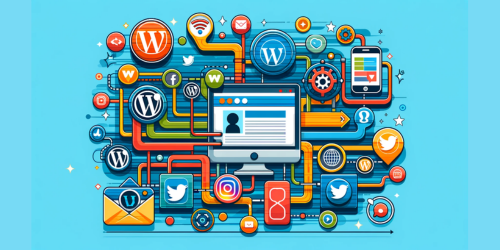Have you ever wondered how you can maximize your productivity with WordPress, even when you’re offline or facing unreliable internet? The answer lies in a local WordPress installation. This method allows you to work on WordPress sites right from your computer, independent of online connectivity.
Setting up a local WordPress site involves installing these components on your machine. It sounds technical, but with the right tools, it’s a breeze, even for non-techies. Let’s embark on this journey to uncover the optimal ways to establish a local WordPress environment on your Mac.
Benefits of Local Installation
Local installations of WordPress come with several compelling advantages:
- Development Flexibility: Whether you’re on a plane or in a café with spotty Wi-Fi, you can continue crafting your website.
- Speed and Efficiency: Local installations offer faster load times and quicker file manipulation, making your development process more efficient.
- Safe Testing Ground: Experiment with themes, plugins, and code changes without the risk of breaking your live site.
- Learning and Training: For beginners, a local environment is a sandbox for mastering WordPress without the public pressure of an online presence.
1. Choosing the Right Tool for Local WordPress Installation
When it comes to setting up WordPress locally on your Mac, selecting the right tool is paramount. Let’s delve into three popular options: MAMP, Local WP, and DevKinsta.
Overview of MAMP, Local WP, DevKinsta
MAMP (Macintosh, Apache, MySQL, and PHP) is a classic choice. It creates a local server environment on your Mac, crucial for running WordPress. MAMP is beloved for its simplicity and effectiveness, especially for beginners.
Local WP is renowned for its user-friendly interface, making it a favorite among both beginners and advanced users. It streamlines the setup process and offers features like live links for sharing your local site.
DevKinsta, developed by Kinsta, is a more recent player. It’s designed specifically for WordPress, offering features like one-click site creation and email testing. It’s a robust tool for those who want deeper functionality.
Key Features of Each Tool
- MAMP: Easy Apache and MySQL setup, customizable server environment.
- Local WP: Intuitive UI, live link sharing, multi-environment testing.
- DevKinsta: One-click WordPress installation, integrated with Kinsta hosting services, advanced database and email tools.
2. Installing WordPress Locally on Mac Using MAMP
Setting up WordPress locally using MAMP involves a few straightforward steps.
Step-by-Step Guide to Install MAMP
- Download and Install MAMP: Visit the MAMP website and download the software. Follow the instructions to install it on your Mac.
- Launch MAMP: Open MAMP from your Applications folder.
- Start Servers: Click on the ‘Start Servers’ button to initiate Apache and MySQL.
Configuring MAMP Settings
- Setting Apache and MySQL Ports: In MAMP settings, set Apache to port 8888 and MySQL to port 8889 for standardization.
- Configuring Document Root: Change the document root to the folder where you want your WordPress files to reside.
3. Installing WordPress Locally on Mac Using Local WP
Local WP simplifies the process of installing WordPress locally.
Detailed Installation Process
- Download Local WP: Go to the Local WP website and download the application for Mac.
- Install and Launch Local WP: Follow the installation guide and launch the application.
- Create a New WordPress Site: Click on ‘Create a New Site’ and fill in the necessary details.
Creating and Managing WordPress Sites with Local WP
- Site Management: Easily manage multiple WordPress sites with Local WP’s intuitive interface.
- Live Link: Share your local site with others using Local WP’s live link feature.
Both MAMP and Local WP offer unique features and functionalities. While MAMP is straightforward and reliable, Local WP adds layers of convenience and advanced options. The choice depends on your specific requirements and preferences.
4. Database Configuration and Management
The backbone of any WordPress site is its database, and managing it effectively is key.
Creating MySQL Databases for WordPress
DevKinsta streamlines the process of setting up a MySQL database for your WordPress site. As part of the site creation process, it automatically configures a new database, but you can also create and manage databases manually through its interface.
Using Adminer for Database Management
DevKinsta comes with Adminer, a lightweight and powerful database management tool. It allows you to manage your WordPress database with ease, offering functionalities for editing tables, running queries, and importing/exporting data.
5. Managing Multiple Sites and Integrations
DevKinsta shines when it comes to handling multiple WordPress sites and integrating with online staging environments.
Handling Multiple WordPress Sites in DevKinsta
DevKinsta supports managing multiple local WordPress sites, each in its isolated environment. This setup allows for unique configurations for each site, providing flexibility and ease of management.
MyKinsta Integration for Staging and Deployment
For those using Kinsta hosting, DevKinsta integrates seamlessly with MyKinsta, allowing you to push your local sites to Kinsta’s staging environments. This feature is incredibly useful for testing changes in a live-like environment before going public. .
DevKinsta stands out as a powerful tool for local WordPress development, offering advanced features and integrations that cater to a wide range of development needs.
6. Conclusion and Moving to a Live Environment
In summary, setting up WordPress locally on your Mac provides a robust and flexible development environment. Whether you choose MAMP for its simplicity, Local WP for its user-friendly interface and live link sharing, or DevKinsta for its advanced features and integration with Kinsta hosting services, each tool offers a unique pathway to creating and managing WordPress sites efficiently and effectively.
The transition from a local to a live environment is a significant step in the lifecycle of a WordPress website. This process typically involves choosing a hosting provider, migrating your local site to the server, and often domain registration. Tools like DevKinsta offer seamless integration for pushing local sites to staging environments, making the transition smoother. Additionally, various plugins and migration tools are available to facilitate this process, ensuring your website retains its functionality and design when moving to a live server.
Embracing the power of local WordPress installations not only enhances your development workflow but also prepares you for a successful launch of your website in the live environment. Remember, the journey from local development to live deployment is a critical phase, warranting careful planning and execution to ensure a smooth transition.
7. Frequently Asked Questions
Q: Where is WordPress located in Linux?
In Linux, WordPress is typically located in the /var/www/html directory for Apache web servers.
Q: How do I open WordPress on Mac?
To open WordPress on a Mac, ensure it’s installed either locally or on a server, then access it via a web browser using the local or server IP address, followed by /wordpress.
Q: How to setup WordPress locally on Linux?
To set up WordPress locally on Linux:
- Install a LAMP (Linux, Apache, MySQL, PHP) stack.
- Create a MySQL database for WordPress.
- Download and extract WordPress to your Apache document root, typically
/var/www/html. - Access and configure WordPress through your local browser.
Also, Delve into WordPress Installation on Linux for more insights.
Q: Where is WordPress installed in cPanel?
In cPanel, WordPress is typically installed in the public_html directory, or a subdirectory within public_html if you choose a specific directory during installation.



